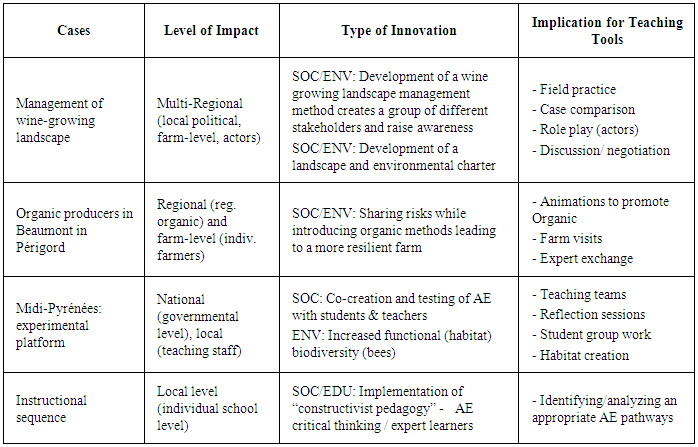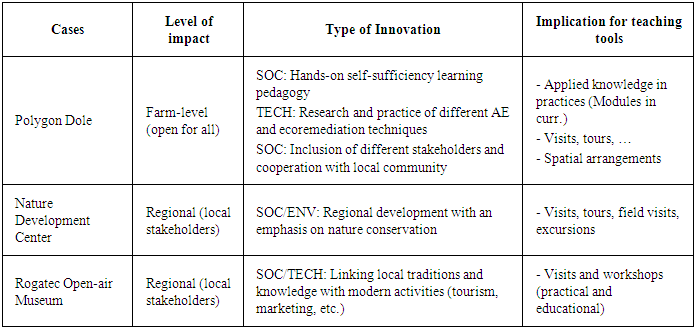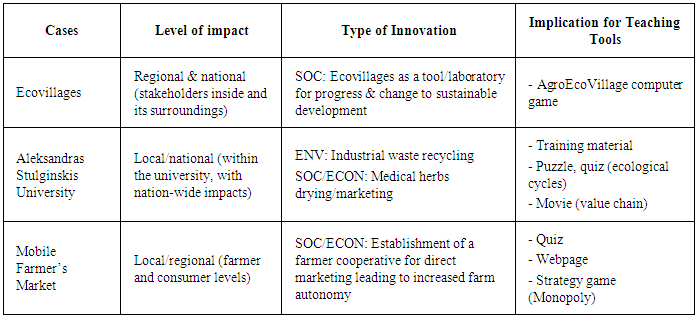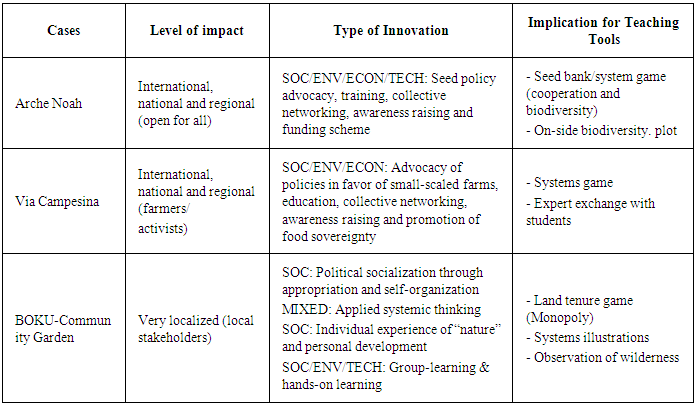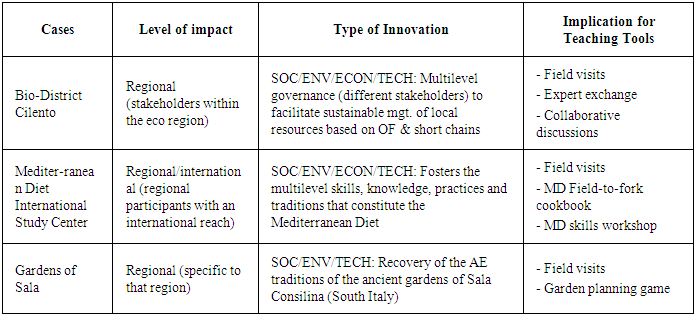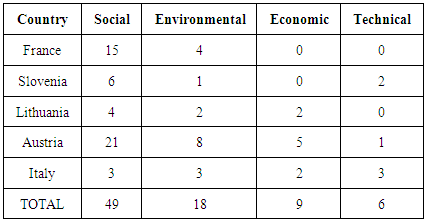-
Paper Information
- Next Paper
- Previous Paper
- Paper Submission
-
Journal Information
- About This Journal
- Editorial Board
- Current Issue
- Archive
- Author Guidelines
- Contact Us
International Journal of Inspiration & Resilience Economy
2018; 2(1): 1-10
doi:10.5923/j.ijire.20180201.01

Agroecology for Our Future
Ana Vovk Korže1, Danilo Korže2
1University of Maribor, Faculty of Arts, International Centre for Ecoremediation, Slovenia
2University of Maribor, Faculty of Electrical Engineering and Computer Science, Slovenia
Correspondence to: Ana Vovk Korže, University of Maribor, Faculty of Arts, International Centre for Ecoremediation, Slovenia.
| Email: |  |
Copyright © 2018 Scientific & Academic Publishing. All Rights Reserved.
This work is licensed under the Creative Commons Attribution International License (CC BY).
http://creativecommons.org/licenses/by/4.0/

The article presents agroecology as a way to a more sustainable society. It is based on agroecological farming, healthy food, supporting biodiversity and the environment with sustainable technologies and on participation of people with different practical activities. The main difference between sustainable development and agroecology is that sustainable development was not based on active practical approaches, but rather on economical, social and environmental aspects, which often existed only on paper. And that is the reason why our planet has still not experienced any visible sustainable changes after more than 20 years. Today, agroecology with practical approaches is becoming more and more important. Practical approaches advocate boot up and integrate lifestyle changes into people's lives. The contribution shows the analysis of selected areas and different agroecological approaches that show new lifestyle trends. Young people are especially susceptible to more responsible ways of living, which include residence (sustainable buildings), reuse and a responsible way of eating (veganism). All of the listed approaches actually lower negative environmental effects, improve people's health and bring new job possibilites. They also encourage young people to develop their free time activities into their permanent jobs. All of this shows that there will be major changes in society in the next few years.
Keywords: Agroecology, Sustainability, Outdoor learning, Education
Cite this paper: Ana Vovk Korže, Danilo Korže, Agroecology for Our Future, International Journal of Inspiration & Resilience Economy, Vol. 2 No. 1, 2018, pp. 1-10. doi: 10.5923/j.ijire.20180201.01.
1. Introduction
- The term agroecology is known worldwide as an integrated system from the food production on traditional basis to alternative forms of food production and processing. Agroecology is a response to the paradox, which we have been experiencing in the recent decades. Conventional agriculture produces massive amounts of food on the expense of negative environmental impacts, nevertheless there are more and more hungry people in the world. Today's famine in the world is not the result of food under-production, but its wrong distribution. One billion people are hungry, but just as many are overweight and consequently have health problems. As the number of population is increasing, the decisive question is how to produce more food, either with chemistry or in a natural, sustainable way and thus reduce the negative impact of livestock farming on climate change in particular. Especially in poor countries poverty is still rising and the most significant climate changes are predicted to happen just there. Classical economic development will no longer be possible. The future of agriculture is in biodiversity, in agroecological farming practices, which include social, economic and environmental objectives as well as natural food production and processing (Gliessman, 2006). The modern trends of teaching agroecology are based on a systemic approach that enables observation and analysis of complex situations in agriculture and food systems. The research and teaching of agroecology stems from sustainable agriculture, which deals with biodiversity protection, concern for fresh pure water, limited natural resources, the availability of agricultural land, food security, social justice and adapting to climate change, among others, which increasingly and drastically affect the production of the quality food. With innovative pedagogical approaches and alternative research methods, the experts in the field of agriculture and food production systems deal with more extensive systemic issues in order to achieve efficient use of renewable resources, food security in modern society, and the resilience of production systems to adverse conditions (Francis et al., 2011).Numerous research and experiences in modern teachings of agroecology have shown that pupils learn most from various practical and research activities, which include case studies and collaboration with different stakeholders in the local environment, e.g. teachers, parents, experts, local farmers, etc. This makes it easier for them to understand the complexity of systems that include the environmental, social and economic dimension. It also gives them a sense of responsibility when executing and completing their projects. Learning agroecology is based on the so-called experiential learning in real-life situations, the key approach being ''learning by doing'' as justified by John Dewey (Francis et al, 2011). This approach enables young people to develop critical thinking skills and the ability to make independent decisions on finding solutions and taking measures to solve real problems in their everyday life and the local environment. While the teacher takes up the role of a mentor, mediator and observer through the learning process, he also encourages and directs students to find a solution for themselves (Leiblein at all. 2012).On the website www.agroecology.org.we can find the interesting representation of agroecology in the world. We find that agroecology today appears in response to emerging conflicts in nature and society, and as a different - alternative way of farming. Agroecological methods should activate traditional practices and link them with innovations, knowledge and new skills as well as people’s attitude towards food with emphasis on healthy and locally produced food. The approaches in agroecology are the most developed in France, which is the leading country in planning, education and implementation of such activities in practice. In the French Action Plan, the Ministry of Agriculture noted the importance of agroecology as an all-encompassing process until 2020, when France becomes the leading country in this field and will integrate farmers into the agroecological farming (Loi d'Avenir, 2014). The implementation of agroecology was based on farmers’ education, activation of the research and acquired knowledge transfer into practice. They are developing agroecological subsistence systems, including the public and monitoring the effects of agroecology in practice (monitoring and evaluation). They devote a lot of attention to education, especially in the field of professional qualifications. In Italy, in 2016, agroecological approaches were classified as mandatory in the organic food production and agroecology was enacted by regulations. The main emphasis now is on the awareness that farms must function as holistic ecosystems. As science, agroecology is part of ecology or landscape ecology, which deals with ecological conditions and processes in agro-ecosystems and with agricultural ecosystems as whole. It does not apply only to agricultural use, meadows and fields for example, but also deals with forests, swamps and processes of degradation, erosion and the outflow of water (Vovk Korže, pp. 6, 2016).The definitions of the term agroecology differ greatly in terms of specificity which defines the term 'ecology'. According to this definition agroecologists can study the state of soil health, water and air quality, meso- and micro-fauna, local plants, toxic substances and other natural contents. A more common definition of the term can be found with authors who see agroecology as a study of interactions between plants, animals, people and the environment in agricultural systems (Loi d'Avenir, 2014). Therefore, agroecology itself is a multidisciplinary science including factors from agronomy, ecology, sociology and economy. Agroecology is also differently defined depending on the geographical location. This approach is the result of understanding the ecosystems as elaborated by Eugene Odum (Odum, 1983). His approach is based on the assumption that natural systems with their stability and resistance are the best model for imitation in agricultural ecosystems. Usually the ecosystems of agroecology are not actively involved in social sciences; however, this school is based primarily on the belief that large-scale farming with massive use of chemicals is detrimental to society. The basic approach of agroecology is derived from agronomy including traditional agricultural practice, which is considered as the heritage of the area (Vovk Korže, pp. 7, 2016).The concept of agroecology appears to be replacing the concept of sustainable development, which has not brought about any significant changes in the recent decades. In agroecology the focus is on using sustainable practices for food production (organic farming). Agroecology is therefore the type of farming that supports nature and does not reduce its ecosystemic benefits and services. It includes ecology also in its products and uses a holistic approach from cultivation to processing. It links ecology with culture, economy and society with the aim of creating a healthy society (http://www.moreandbetter.org/en/news/a-viable-food-future). Such systems are a characteristic of agricultural areas in African and Asian countries, where they provide themselves with food and energy completely. The use of agroecology increases the soil fertility; the soil becomes more resistant to drought and climate changes, the communities are more connected and positively affect the entire ecosystem (water is retained by vegetation and not by using artificial irrigation and pesticides) (Vovk Korže, pp. 7, 2016).Agriculture and food production are the basis of life and have multifaceted effects on society. They have an important influence on prosperity and hunger, on climate changes and the environment. They both involve women workforce and offer a variety of jobs. Agroecological production involves the local environment and seeks solutions on the local level (Vovk Korže, pp. 7, 2016).The concept of agroecology may seem complicated, but in reality it is clearly based on skills and knowledge, efficient use of resources to the maximum, problem solving and reducing the costs (http://www.moreandbetter.org/en/nevs/a-viable-food-future). This requires constant adaptability and innovations. The transition to green agriculture is beneficial to all and allows local communities to plan and create their own development. The quality of food depends on the way how it is produced and directly affects the health of all living beings (Vovk Korže, pp. 8, 2016).In order to apply the principles of agroecology it is important to know the holistic sustainable production system based on traditional knowledge and local experiences, which needs to be upgraded with modern ecological, social and agronomic knowledge. The purpose of this approach is also to preserve and improve agricultural production, to ensure a healthy, natural and living environment and to provide quality food as well as maintaining self-sufficiency of local communities (Vovk Korže, pp. 9, 2016).The agroecological system can operate on various levels, either on the field, garden or farm level, local community or in the entire region or state. The essential agroecological strategy of creating a stable system is based on the integration of diversity in the agricultural land and the local landscape. The diversity on the field level or farm level is understood as species diversity, crop rotation, polyculture instead of monoculture, forestry, a combination of agriculture and livestock farming, the use of green manure plants and drapes. On the landscape level it is the establishment and maintenance of a system of green infrastructures, which is co-shaped by borders, wind-barriers, ponds, grass belts, bypass and water corridors. These stable and varied agroecological systems boost the improvement of soil quality, resistance to disease and higher productivity of crops as well as preserve the nutrients.With the help of agroecological arrangements on the micro-level, i.e. in the garden, field or the entire farm, we adapt to the natural factors as much as possible and use natural local renewable sources. We use natural resources such as solar energy for heating water and electricity, we collect and reuse water sources such as spring water or rainwater and use the energy of soil to store seeds and crops. This reduces the need for external energy inputs and reduces the operating costs of farming. (Vovk Korže, pp. 9, 2016).We use the excess biomass for composting purposes and return it to beds after a year. Compost will additionally retain moisture and consequently we will improve the quality of the soil. To cover the field surfaces, use hay or straw mulch, which prevents the growth of weeds, keeps moisture and improves the soil, therefore no earth-working machines are required. As for simple garden arrangements, such as shaft beams and other supporting garden elements, recycled natural materials can be used. We can also include useful organisms in the farming system, which are attracted by properly regulated housing and food sources. With such agroecological approaches we will conclude a series of natural processes in the garden or in the field and strengthen the natural system to remain self-sufficient and resistant to external negative factors such as weather disturbances, pests and diseases. The nature will reward us with the abundance of quality crops that will help us live healthily (Vovk Korže, p. 10, 2016).At macro level, agroecology is becoming more and more established as a way of living and functioning of the community, and as a responsible management of natural resources (Vovk Korže, p. 10, 2016).Agroecology is based on scientific and traditional knowledge. It is a science that bridges ecological and socio-economic aspects. It can work at various levels – farm, community, national, regional, etc. Biological processes are enhanced using agroecological principles and these principles can be shared via farmer-to-farmer exchanges. Agroecology needs to be built from the bottom up, especially through social movements in rural areas (https://agroeco.org/wp-content/uploads/2015/11/Agroecology-training-manual-TWN-SOCLA.pdf).Agroecologists often see the addition or the umbrella of agroecology to organic agriculture as a possibility to further guide the current organic system by including additional agroecological principles. Because of agroecology’s distance from institutionalization to the extent of organic with standards, regulation, certification, and political agendas, it is also seen as a possibility to circumvent some of the economic and institutional interests and to replace resulting hindrances with possibilities that come from a less manipulative form of sustainable agriculture (Altieri & amp; Nicholls, 2003). Agroecology is seen by some as a possibility to rescue organic farming from the risks of conventionalization.Climate change, altered global water, cycle, human migration, population growth, urbanization, food production and food security, energy and natural resource management are interconnected and intertwined and therefore they cannot be addressed separately. Policies are essential instruments for promoting the sustainability of landscapes, agriculture, cities and rural development. In this article we have collected, synthesized and summarized the identified best-case case studies of agroecological innovations within the selected EU countries.
2. Methodology
- We used the methods of synthesis and comparison of the different definitions of agroecology, and the cases in terms of assessment of the case studies through: - level of impact- type of innovation and - implications for teaching tools We used different resources about the agroecology and the resources from the project Erasmus+ Teaching agro-ecology in transitory period and its Consequences for the Agricultural Knowledge Systems. The main sources are Output 1 https://0x9.me/z7lAg and Output 2 http://www.ff.um.si/dotAsset/69535.pdf. The goal was to understand the process of agroecology in Europe. All of the causes are sustainable and showed the practical orientation and results on the local, regional and global level. We compared agroecology in France, Slovenia, Austria, Lithuania and Italy.
3. Results and Discussion
- Agroecology in FranceIn France, the approach towards agroecology is strongly influenced by the public policy project "Agroecology, a new production paradigm” to mainstream agroecological practices into the overwhelming intensive production of the agricultural sector. The public policy project is accompanied by a second action plan the "Teaching agroecology, a new production paradigm”. AE was defined as farm autonomy and the improvement of their competitiveness by lessening the consumption of energy, water, fertilizers, phytopharmaceutical products and veterinary medicines. It comes to integrating the ecological dimension as a competitiveness factor. Agroecology is defined as technical, pedagogical, and organizational as it is in the context of the French action plan to implement agroecology at a national level. The presented agroecological innovations in Case study 1 (Management of wine-growing landscape) are seen on the one hand in the creation of a group of different stakeholders from the region, which is developing a wine-growing landscapes management method (incl. tools to support and guide this development). This process raises awareness among the group about certain agroecological practices (and their impacts on the ecosystem services, but also on the level of heritage conservation) implemented in a defined region and on the other hand in the development of a landscape and environmental charter promoting these AE practices seeking to influence public policies to promote them. Case study 2 (Organic producers from Beaumont in Périgord) present sharing the risks of changing the (production) techniques (introduction of Organic farming principles) leading to a more resilient farm in both the economic perspective and environmentally by enhancing grassland diversity). The Case study 3 (An experimental platform in Agroecology for training and development in Midi-Pyrénées) lays in the institutionalization of Co-creation and testing of adapted agroecological practices with students, teachers and farmers in the training requirements books of “Brevet de technicien supérieur” (BTS) Agronomie Productions Végétales (APV) whereas all stakeholders are put into a case study learning situation at farms to examine agroecological practices and the implementation of derived initiatives (such as the Casdar Pollinis´acteur) increasing functional (habitat) biodiversity (bees).In Case study 4 – the instructional sequence to accompany the agroecological transition – is seen in the implementation of a “constructivist pedagogy” to enable critical thinking in students to become expert learners by elaborating different trajectories towards applied AE on different levels and in professional situations.
|
|
|
|
|
|
4. Conclusions
- Climate change, altered global water cycle, human migration, population growth, urbanization, food production and food security, energy and natural resource management are interconnected and intertwined and therefore they cannot be addressed separately. Policies are essential instruments for promoting the sustainability of landscapes, agriculture, cities and rural development. Agroecology is as a way for sustainability with practical results. In France, agroecology is central in public policies (at central and local level), there are specific national programs and action plans. The public policy project "Agroecology, a new production paradigm” aims to promote the evolution of French agriculture into agroecology (the agroecological transition) and the development of practices and innovative systems to achieve the triple performance (environmental, economic and social). This project is accompanied by a second action plan "Teaching agroecology, a new production paradigm”. In order to standardize the range of meanings relating to agroecology, an official definition was written. As in Austria and Italy, there is a significant experience of Eco (Bio)-Region, BioVallèe, in the Drôme Valley. The ambition is strong but the “weight” of conventional sector can be an obstacle to the generalization of the organic.In Slovenia, the agroecology as a sustainable agriculture concept is not officially applied in the strategic policy, but some sustainable principles linked with agroecology are already carried out, especially at local and regional level, mostly due to the preserved traditional agricultural management and knowledge of small family farms. Organic farming is gaining increasing importance in the Slovenian agricultural area. Alternative sustainable agriculture practices, such as biodynamics and permaculture, have gained a big support mostly among the general public and local farmers.In Lithuania, the agroecology is not a priority area of the national policies, however the sustainable agriculture and sustainable rural development are defined as a priority. The organic farming has a history of 25 years in the country. The number of organic farms increases due to support by the European Agriculture Fund for Rural Development, mainly. The Lithuanian Institute of Agrarian Economics implemented a project on the ecovillages. The aim of the project is to collect experiences and good practices in the Baltic Sea area and foster the development of ecovillages as a more sustainable way of living in the region. In Italy, agroecology is considered today a transdisciplinary field of enquiry that is capable of changing our common vision of both agriculture and society (Caporali). There isn’t a national program. The Agroecological transition (in particular with organic farming) started from the farmers, without public support, rather to respond to consumer’s demand. The organic sector shows concrete agroecological solutions for agriculture and food systems. The Bio-districts experience, originated in the year 2004 by AIAB Campania in Cilento area (Province of Salerno), is today spreading across the country (15 Bio-districts in 10 regions). In Austria, agroecology is at a crossroad (from science to movement). It is inherently connected to the organic farming (as in Italy, Lithuania and Slovenia) and there is a significant experience of organic territorial approach in the province of Upper Austria (Bioregion Mühlviertel). The model of Eco (Bio)-region is very popular in Italy, too. An important level for the development is represented by the “Bio-Aktionsprogramm 2015-2020”. The Agri-environmental Program allowance for less-favored areas, a “biobonus”. Furthermore, agroecology may benefit from the popularity and acceptance of the Organic movement. However, the distance of agroecology as a science to agroecology as a movement must be bridged in order to have a successful future.
 Abstract
Abstract Reference
Reference Full-Text PDF
Full-Text PDF Full-text HTML
Full-text HTML